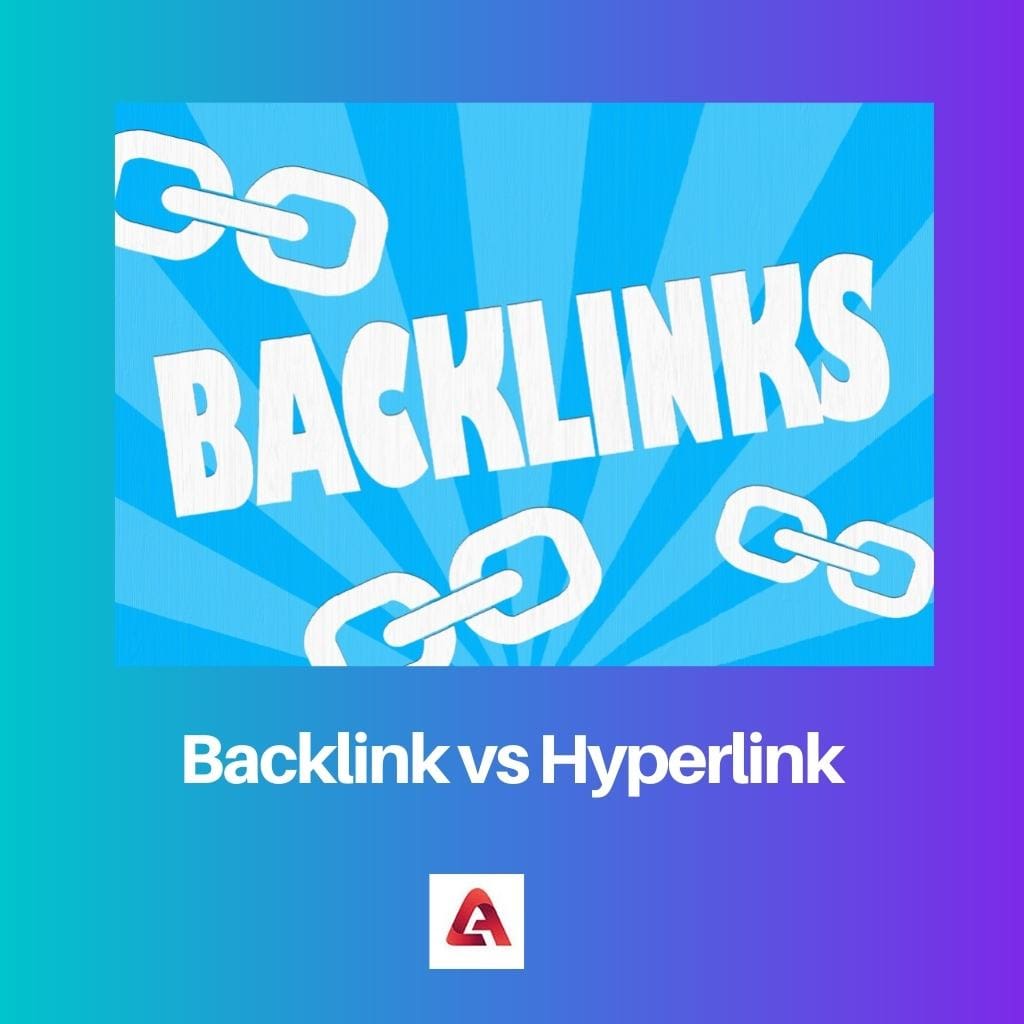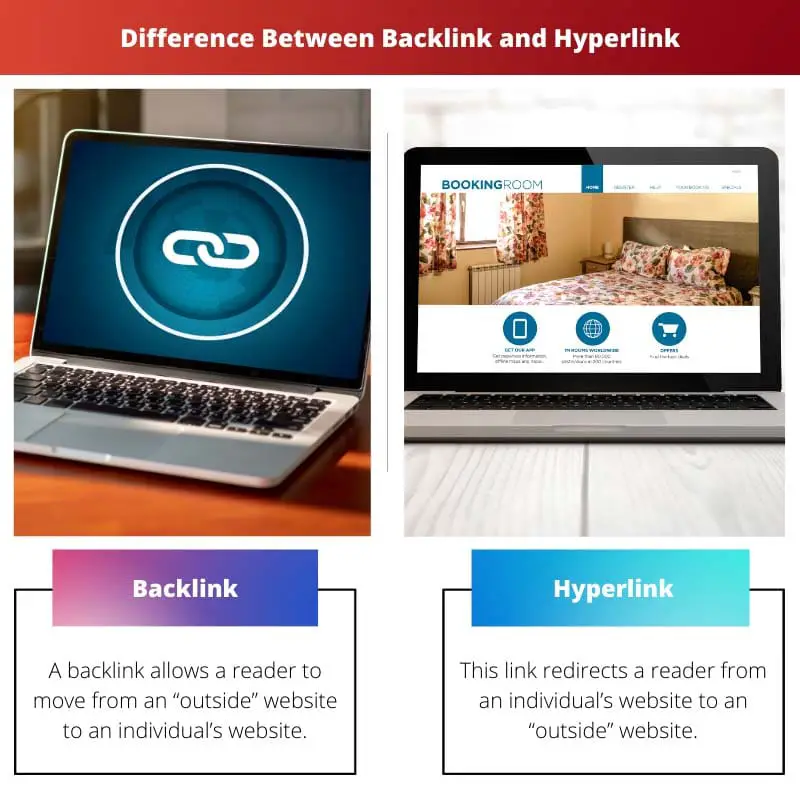A backlink is a link from one webpage to another webpage, on a different website. It serves as a reference or citation, improving a site’s search engine ranking. Conversely, a hyperlink is a link within a webpage that allows users to navigate to another webpage or resource, within the same site.
Key Takeaways
- Backlinks refer to links from external websites that lead to a particular website, improving its search engine rankings.
- Hyperlinks refer to clickable text or images that lead to another web page or a different section of the same page.
- Backlinks are a crucial aspect of search engine optimization, while hyperlinks are a fundamental element of web page navigation.
Backlink vs Hyperlink
The difference between Backlink and Hyperlink is that Backlink is a link created as a one-way path that links a given website to another. On the other hand, a Hyperlink is just any link used to navigate a given website.

Comparison Table
| Feature | Backlink | Hyperlink |
|---|---|---|
| Direction | Inbound (points to your website) | Outbound (points away from your website) |
| Origin | Created on another website | Created on your website |
| SEO Impact | Directly impacts your website’s search engine ranking (higher quality and quantity leads to higher ranking) | No direct impact on your website’s search engine ranking, but can improve user experience |
| Control | You have no control over backlinks (you cannot create them yourself) | You have full control over hyperlinks (you can choose where they point and what text is used) |
| Example | A news website links to your blog post in their article | You link to a relevant Wikipedia article in your blog post |
What is a Backlink?
A backlink, also known as an inbound link or incoming link, is a hyperlink that directs users from one webpage to another webpage, on a different domain. In the realm of search engine optimization (SEO), backlinks play a crucial role in determining a website’s authority, relevance, and overall ranking on search engine results pages (SERPs).
Importance of Backlinks in SEO
Backlinks serve as a vote of confidence from one website to another. Search engines like Google consider backlinks as indicators of a website’s credibility, popularity, and trustworthiness. Websites with a higher number of quality backlinks are perceived as more authoritative and are thus more likely to rank higher in search engine results.
Types of Backlinks
- Natural Backlinks: These are earned organically when other websites find a webpage valuable and link to it without any solicitation.
- Manual or Editorial Backlinks: These are acquired through deliberate efforts, such as outreach campaigns or guest posting, where website owners actively seek links from other sites.
- Self-Created Backlinks: These are generated by individuals through various means, such as forum signatures, blog comments, or directory submissions. However, they are of lower quality and may be disregarded by search engines.
Factors Affecting Backlink Quality
- Relevance: Backlinks from websites that are topically relevant to the linked webpage are considered more valuable.
- Authority: Backlinks from high-authority websites with established credibility carry more weight in influencing search engine rankings.
- Anchor Text: The text used in the hyperlink (anchor text) provides context to search engines regarding the linked webpage’s content. Relevant anchor text can positively impact SEO.
- Diversity: A diverse backlink profile consisting of links from various domains and sources is preferable, as it indicates natural link-building activity.

What is a Hyperlink?
A hyperlink, referred to simply as a link, is a selectable element within an electronic document that, when clicked or activated, redirects the user to another location, such as another section of the same document, another document, or a webpage on the internet. Hyperlinks are fundamental to navigating the web and connecting various resources.
Anatomy of a Hyperlink
- Anchor Text: This is the visible, clickable text or image that users interact with to activate the hyperlink. Anchor text provides context and indicates the destination of the link.
- URL (Uniform Resource Locator): The URL specifies the target destination of the hyperlink. It can point to various resources, including webpages, files, images, or sections within a document.
Types of Hyperlinks
- Text Hyperlinks: These hyperlinks are embedded within text content and appear as underlined or differently colored text. Clicking on the text activates the hyperlink, directing the user to the linked destination.
- Image Hyperlinks: In addition to text, hyperlinks can also be associated with images. Clicking on the image activates the hyperlink and redirects the user to the specified destination.
- Internal Hyperlinks: Internal hyperlinks connect different sections or pages within the same document or website. They facilitate navigation and help users find relevant information within the same context.
- External Hyperlinks: External hyperlinks point to resources located on external websites or domains. They enable users to access a vast array of information available on the internet.
Functions of Hyperlinks
- Navigation: Hyperlinks allow users to navigate seamlessly between different webpages, documents, or sections within the same content.
- Information Retrieval: Hyperlinks serve as references or citations, enabling users to access additional information or related resources on a particular topic.
- Interaction: Hyperlinks enhance user interaction by providing clickable elements that facilitate exploration and engagement with digital content.
- Search Engine Optimization (SEO): In the context of SEO, hyperlinks, particularly backlinks from external sources, play a significant role in determining a website’s authority and relevance, thereby influencing its ranking in search engine results.

Main Differences Between Backlinks and Hyperlinks
- Nature:
- Backlinks are links from one webpage to another webpage, on different domains.
- Hyperlinks are links within a webpage that direct users to another webpage, section of the same document, or external resource.
- Direction:
- Backlinks point from one website to another, serving as references or citations.
- Hyperlinks can be both internal (within the same document or website) and external (to other websites).
- SEO Impact:
- Backlinks are crucial for SEO, as they influence a website’s authority, relevance, and ranking in search engine results.
- Hyperlinks within a webpage facilitate navigation and user interaction but do not directly impact SEO unless they are part of a backlink profile pointing to the website.
- Purpose:
- Backlinks are used for citation, reference, and endorsement purposes, contributing to a website’s credibility and trustworthiness.
- Hyperlinks are primarily used for navigation, information retrieval, and user interaction within digital content.
- Visibility:
- Backlinks may not always be visible to users on a webpage but are visible to search engine crawlers.
- Hyperlinks are visible and clickable elements within a webpage, allowing users to navigate to different sections or external resources.



